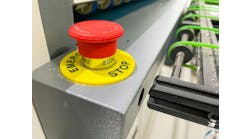My good friend, David Gilliam, was a hydro worker. He worked on high-voltage lines for a local hydro company. He is a smart guy and never checked his head at the door when he went to work. Except for this one day.
He was up in the bucket to do some work on a tower, and he forgot to check the breaker to see if the source power had been removed. He called down to the secondary worker, who was on the ground at the substation, and asked him to verify that the breaker had been switched off.
The answer was, yes, it had been. While I wasn’t there at the time, the story has a bit of a hole in it since it is unclear if the secondary person actually checked or assumed. David began working and his two arms literally were blown off by the energy in the power lines. He lost them from the shoulders. The story doesn’t end there though.
Today, he is a functioning father and grandfather who still builds things and drives himself, and, of course, he has a smart home. He is in this position because he didn’t check things for himself and relied on information from someone who obviously checked his head at the door when he left for work that day.
Companies are getting fined every day for worker injuries that could have been prevented by implementing safety standards to protect workers who in fact check their brains at the time clock that they punch when they arrive for work.
Whose responsibility is it anyway? In my mind, it is everyone’s responsibility, but ultimately it lies on each individual.
Safe working environments are a necessity. OSHA demands certain standards for all kinds of situations, such as confined-space working conditions and arc-flash protection when working on panels.
Some of the required safety practices go so far overboard however that they are not followed because people can’t be bothered.
Good safety practices in automation should be implemented to protect the surrounding equipment, processes and people. Simple safety circuits require the use of a safety relay with an e-stop, at the very least. Larger safety systems can employ a safety PLC or multiple safety PLCs in order to protect the system.
I was involved in a safety scheme for a warehouse wrapper system which employed four different PLCs, and the pre-start health and safety review (PSR) determined that we needed four safety PLCs that needed to work together and also be independent.
We chose Pilz for the hardware, which turned out to be a good move. It had a link module that linked each safety PLC together for integrity, which solved the integration-of-the-three-systems issue.
The light curtains had to be safety-rated, meaning there were two outputs from the curtain, which used a pulse system to determine if a wire had fallen off or been broken. This is because the PSR suggested that someone could ride a pallet from the entry point, and then that person could run up the conveyor into the wrapper and get wrapped. Imagine that.
That could never happen.
Ask David Gilliam what could never happen, and he would have a story for you.
Safety systems are all about making sure the environment is safe, especially for people. When an e-stop is hit, there can’t be any discussion on whether the power is still applied in the panel or not. But it still behooves the electrician to personally make sure that in fact there is no power in the system before he begins his troubleshooting.
There are times where things just go too far, as well. At the output of the wrapper, there was a small section of conveyor leading into a receiving station that was manned by an operator. Safety requirements stated that there had to be a door separating the station and the operator and that door had to have a safety door switch to turn off all equipment when the door was opened.
That premise was a good one until it was realized that the door was opened multiple times during a shift, stopping production, and recovery was not simple. The sensor was removed from the door jamb and tie-wrapped to the switch, so the safety was removed.
Was that a good idea to implement? The PSR engineer had to do that because, if someone got hurt, then he would be on the hook because he didn’t have that covered.
In our litigious society, safety (read, personal injury) is becoming a required theme to protect people from themselves, and probably can’t go too far.
But, when people continue to check their heads at the door, sometimes safety can’t go far enough. Safety PLCs make the job relatively easy, albeit not necessarily inexpensive.
Be smart in your implementations of safety PLCs and you protect everyone. As the safety automation developer, you can’t check your head at the door. It’s up to you.






